Improved Topographic Normalization for Landsat TM Images by Introducing the MODIS Surface BRDF
Abstract
:1. Introduction
2. Methods
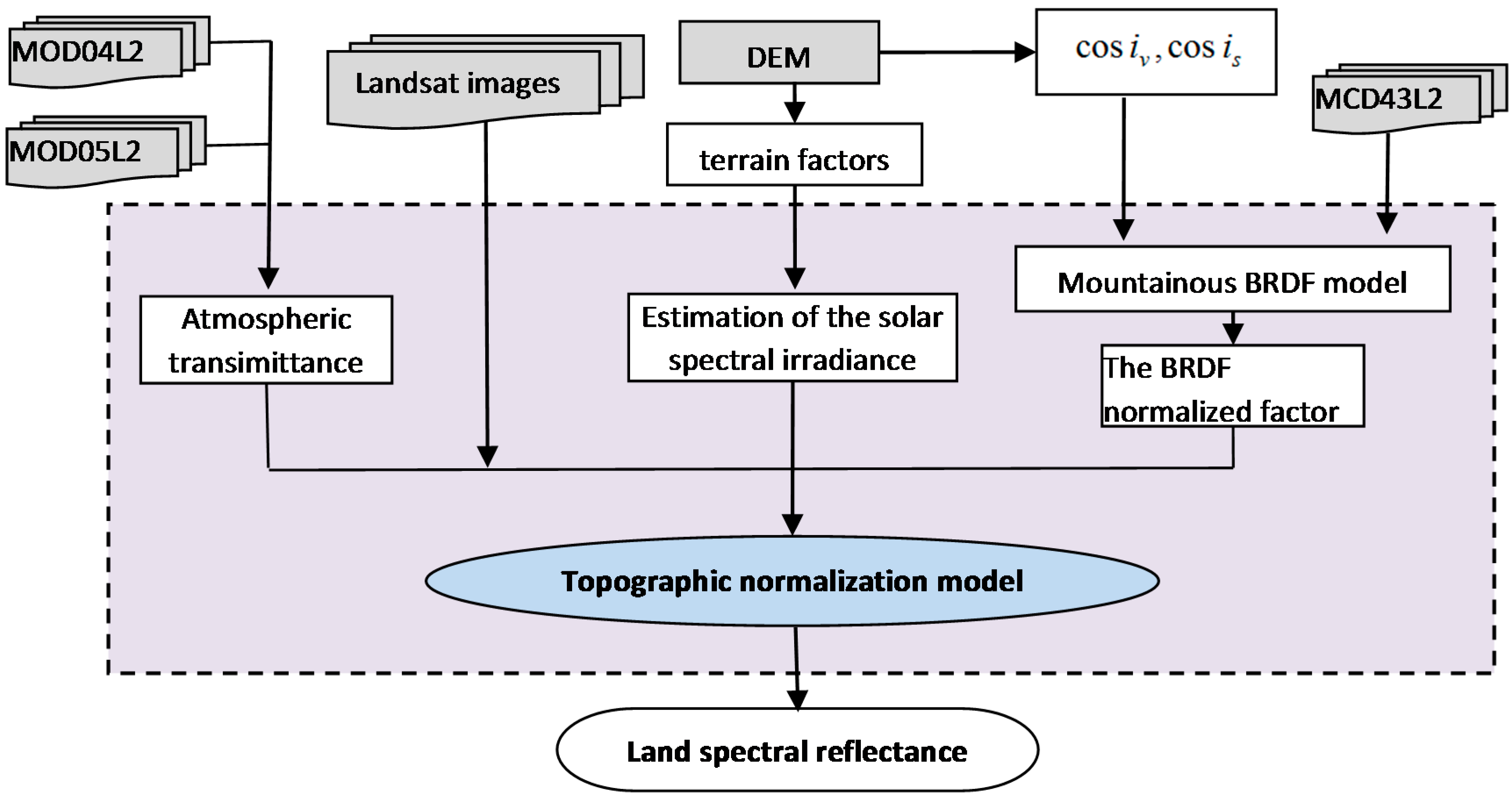
2.1. Improved Topographic Normalization
2.2. Comparison of Four Correction Algorithms
| Method Name | DEM and Terrain Factors | PW | AOD |
|---|---|---|---|
| MODIS-based BRDF algorithm (MBBA) | YES | MOD05L2 | MOD04L2 |
| MODIS-basedLambertian algorithm (MBLA) | YES | MOD05L2 | MOD04L2 |
| MODIS-based atmospheric correction (MBAC) | NO | MOD05L2 | MOD04L2 |
| Landsat climate data record (CDR) | NO | -- | -- |
| Fast line-of-sight atmospheric analysis of spectral hypercubes (FLAASH) | NO | - |
3. Description of the Input Parameters
3.1. Atmospheric Transmittance
3.2. Estimation of the Solar Spectral Irradiance
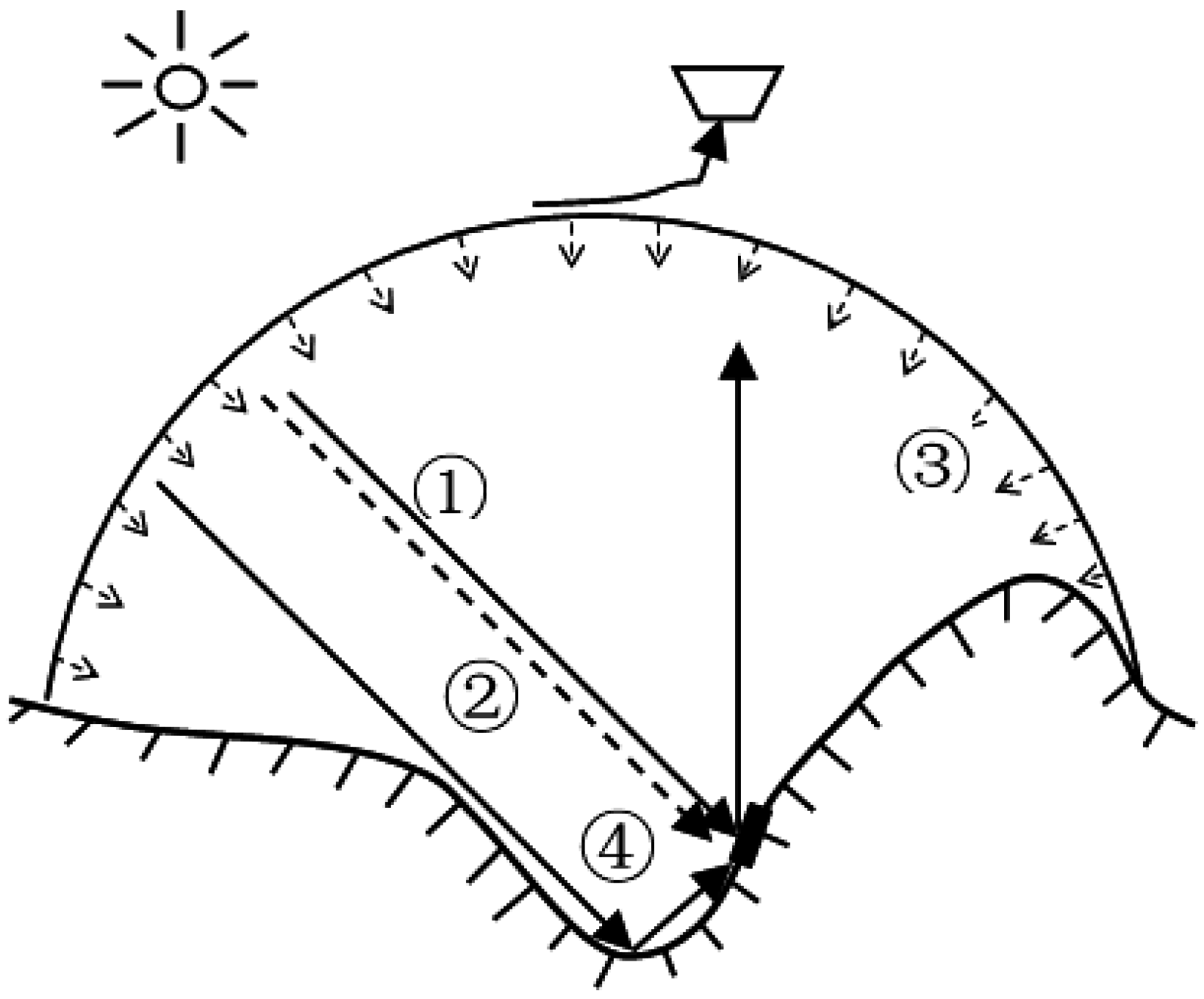
3.3. Bidirectional Reflectance Distribution Function (BRDF) Model
4. Results and Validation
4.1. Study Area and Data
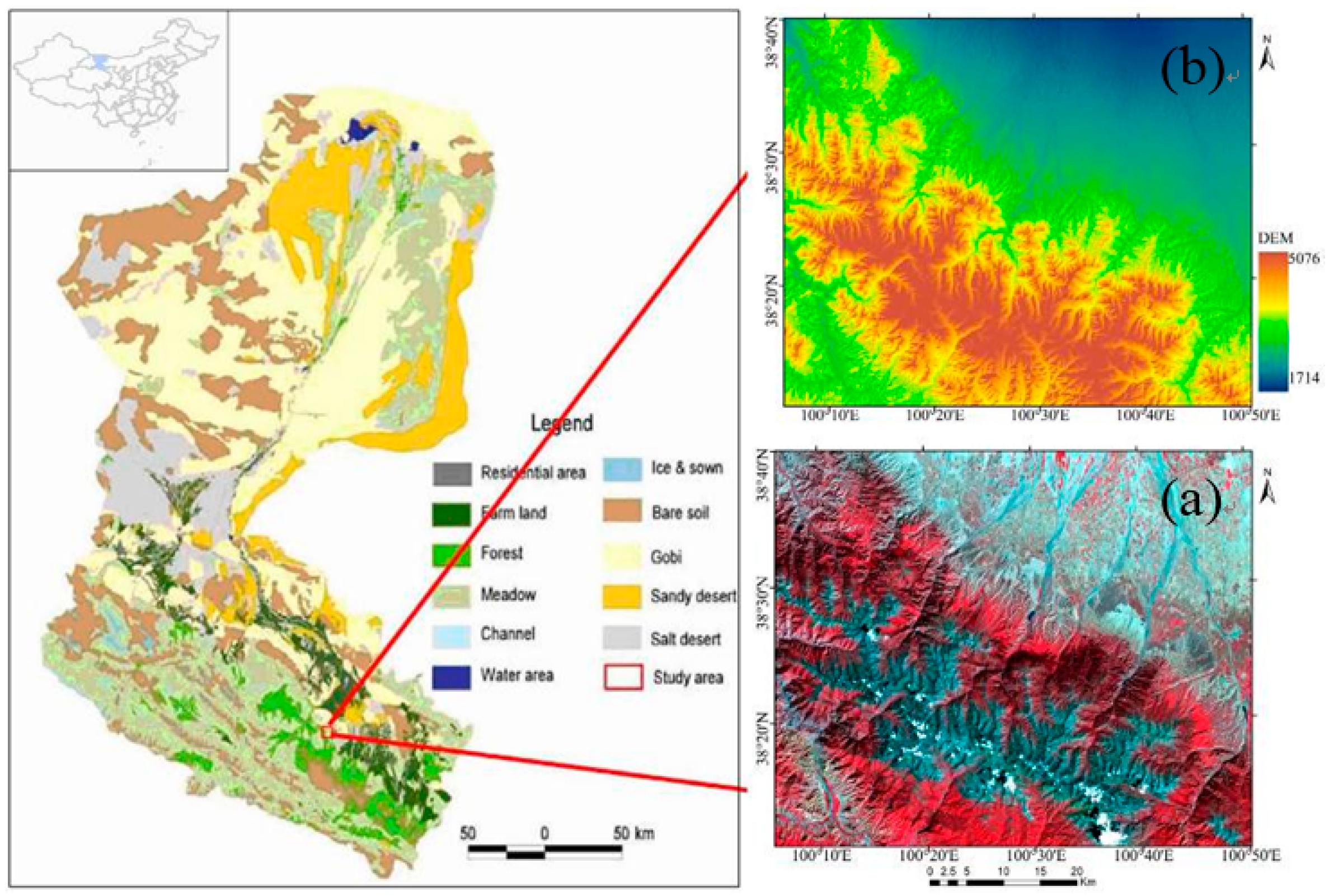
4.2. Bidirectional Reflectance Distribution Function (BRDF) Normalized Factor
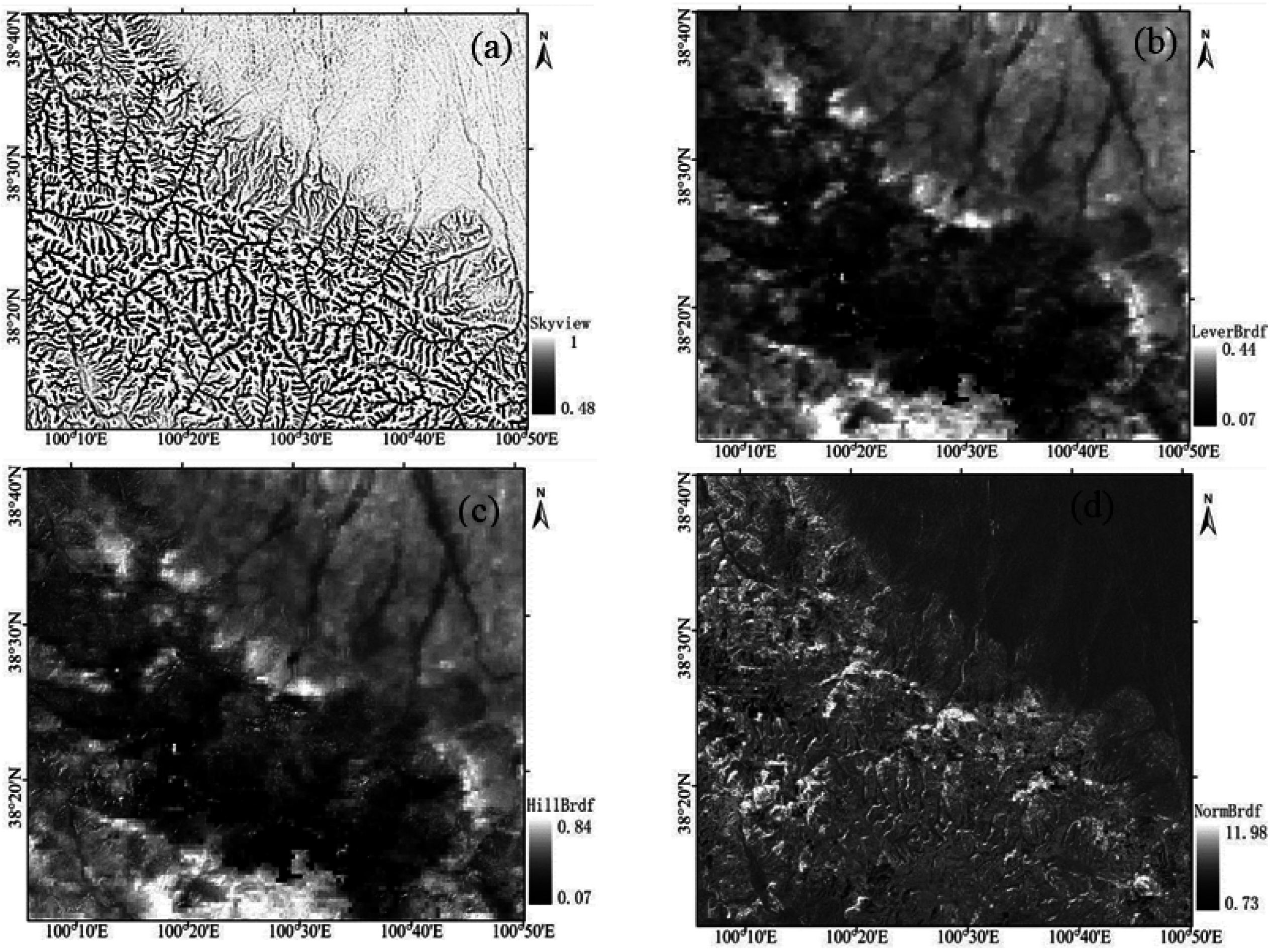
4.3. Validation and Discussion
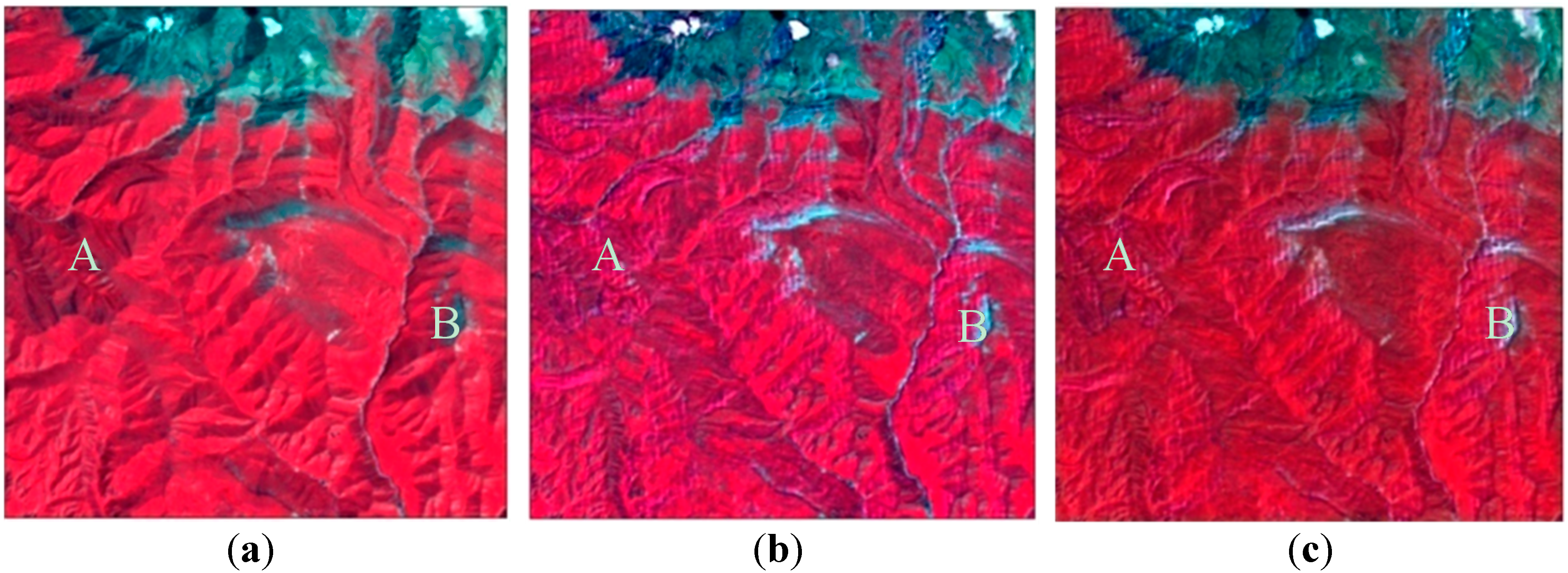
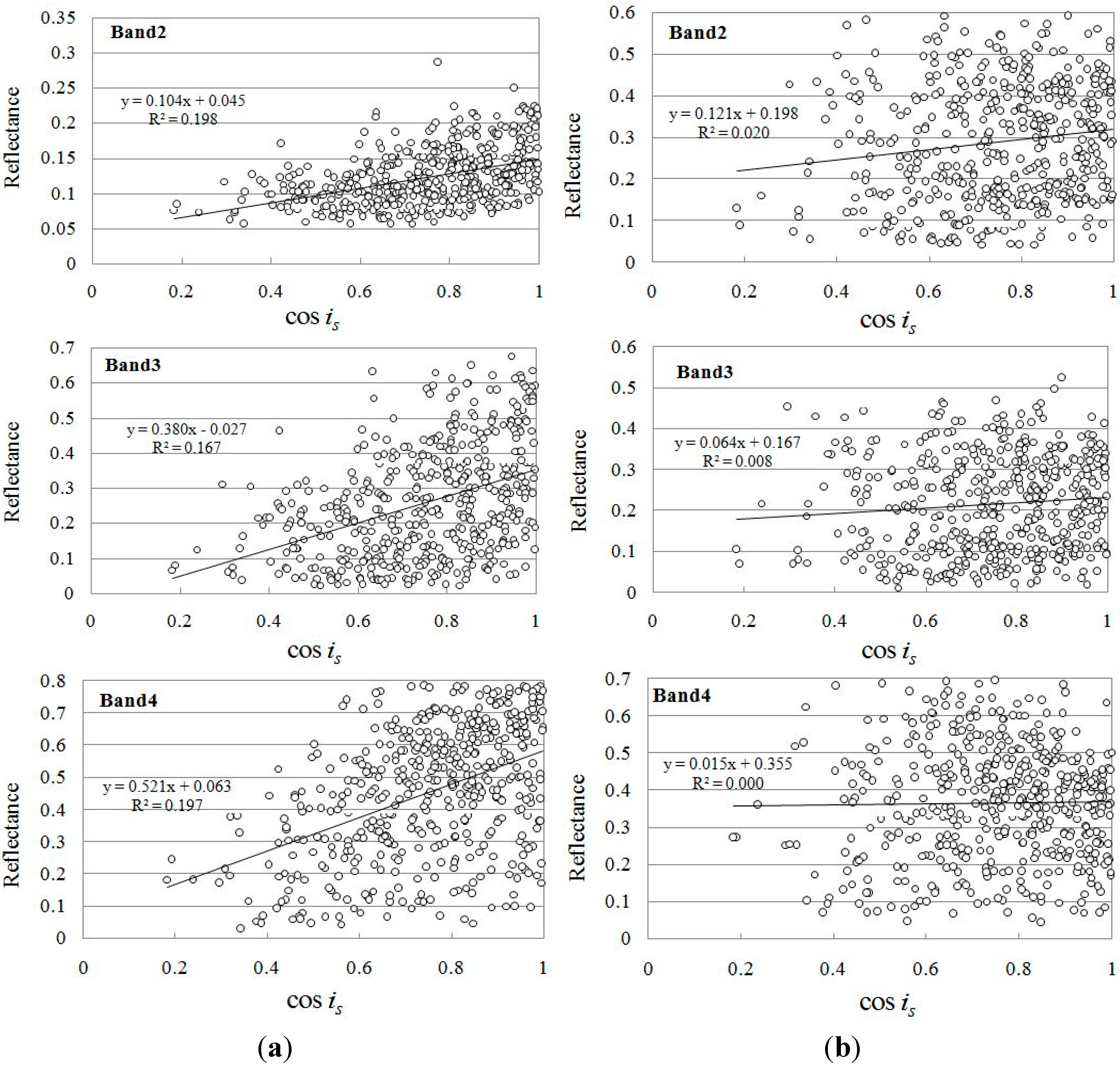
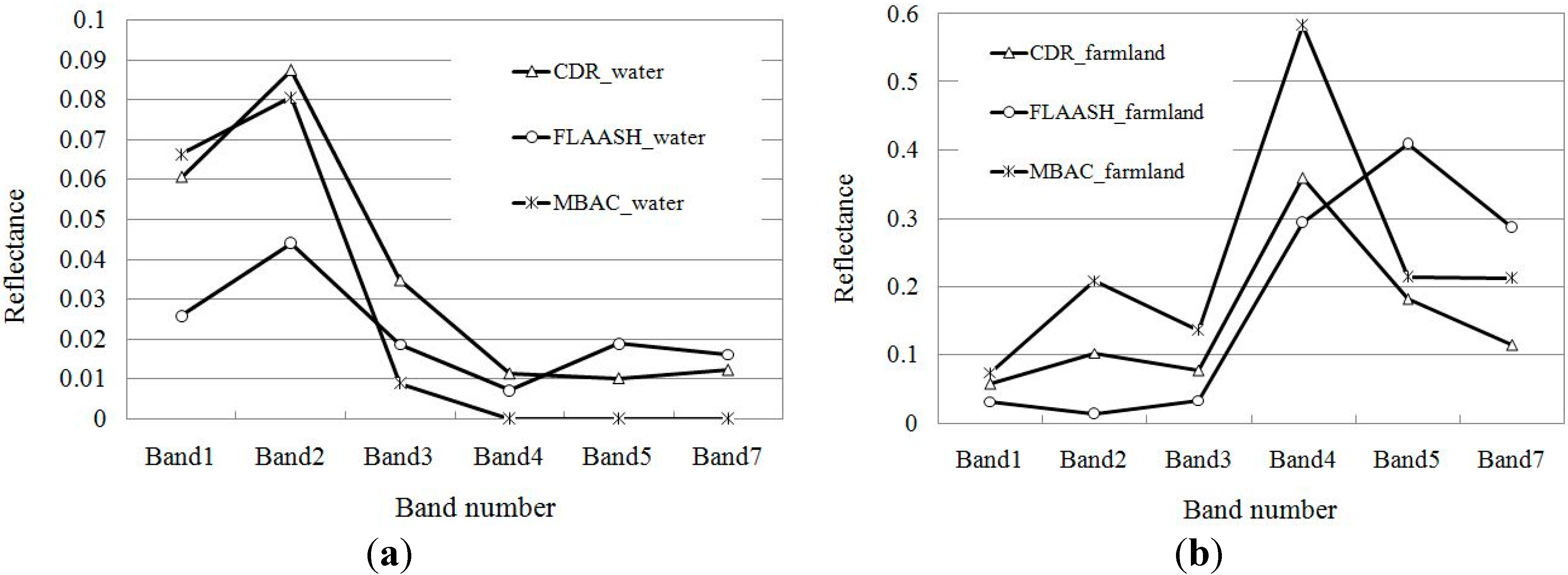

5. Conclusions and Discussion
Acknowledgments
Author Contributions
Abbreviation
| DSSR | downward surface shortwave radiation (W∙m−2) |
| AOD | aerosol optical depth |
| PW | precipitable water (cm) |
| BRDF | surface bidirectional reflectance distribution function |
| DEM | digital elevation model |
| TOA | top of the atmosphere |
at-satellite radiance | |
path radiance | |
reflected radiance from the land surface | |
atmospheric transmittance from the observing direction | |
extraterrestrial solar spectral irradiance (W∙m−2∙µm−1) | |
global spectral irradiance (W∙m−2∙µm−1) | |
direct spectral irradiance (W∙m−2∙µm−1) | |
isotropic diffuse spectral irradiance (W∙m−2∙µm−1) | |
anisotropic isotropic diffuse spectral irradiance (W∙m−2∙µm−1) | |
surrounding-reflected spectral irradiance (W∙m−2∙µm−1) | |
diffuse spectral irradiance on the horizontal surface | |
directional-directional reflectance | |
hemispheric-directional reflectance | |
slope and aspect | |
zenith and azimuth angles in the directions of solar incident | |
zenith and azimuth angles in the directions of sensor observations | |
actual zenith and azimuth angles in the directions of solar incident due to topographic effects | |
actual zenith and azimuth angles in the directions of sensor observations due to topographic effects | |
inclined surface directional-directional reflectance | |
flat surface directional-directional reflectance | |
BRDF normalized factor | |
calibration factor for the Sun-Earth distance | |
solar zenith angle | |
cosine of the solar illumination angle of a sloping grid | |
obstruction coefficient | |
global spectral transmittance | |
spectral transmittance caused by ozone | |
spectral transmittance caused by water vapor absorption | |
spectral transmittance caused by Rayleigh scattering | |
spectral transmittance caused by aerosol scattering | |
sky view factor | |
topographic configuration factor | |
| K | circumsolar view factor or anisotropy index |
surface-reflected radiance measured via a satellite |
Conflicts of Interest
References
- Flood, N.; Danaher, T.; Gill, T.; Gillingham, S. An operational scheme for deriving standardised surface reflectance from Landsat TM/ETM+ and SPOT HRG imagery for Eastern Australia. Remote Sens. 2013, 5, 83–109. [Google Scholar] [CrossRef]
- Flood, N. Testing the local applicability of MODIS BRDF parameters for correcting Landsat TM imagery. Remote Sens. Lett. 2013, 4, 793–802. [Google Scholar] [CrossRef]
- Kobayashi, S.; Sanga-Ngoie, K. A comparative study of radiometric correctionmethods for optical remote sensing imagery: the IRC vs. other image-based Ccorrection methods. Int. J. Remote Sens. 2009, 30, 285–314. [Google Scholar] [CrossRef]
- Liang, S.; Fang, H.; Chen, M. Atmospheric correction of Landsat ETM+ land surface imagery. I. Methods. IEEE Trans. Geosci. Remote Sens. 2001, 39, 2490–2498. [Google Scholar] [CrossRef]
- Li, F.; Jupp, D.L.; Reddy, S.; Lymburner, L.; Mueller, N.; Tan, P. A physics-based atmospheric and BRDF correction for Landsat data over mountainous terrain. Remote Sens. Environ. 2012, 124, 756–770. [Google Scholar] [CrossRef]
- Kruse, F.A. Comparison of ATREM, ACORN, and FLAASH atmospheric corrections using low-altitude AVIRIS data of Boulder, CO. In Proceedings of the 13th JPL Airborne Geoscience Workshop, Pasadena, CA, USA, 31 March–2 April 2004.
- Masek, J.G.; Vermote, E.F.; Saleous, N.E.; Wolfe, R.; Hall, F.G.; Huemmrich, K.F.; Gao, F.; Kutler, J.; Lim, T.K. A Landsat surface reflectance dataset for North America, 1990–2000. IEEE Geosci. Remote Sens. Lett. 2006, 3, 68–72. [Google Scholar] [CrossRef]
- Li, F.; Jupp, D.L.B.; Reddy, S.; Lymburner, L.; Mueller, N.; Tan, P.; Islam, A. An evaluation of the use of atmospheric and BRDF correction to standardize Landsat data. IEEE J. Sel. Top. Appl. Earth Observ. Remote Sens. 2010, 3, 257–270. [Google Scholar] [CrossRef]
- Liang, S.; Fang, H.; Chen, M.; Shuey, C.J. Validating MODIS land surface reflectance and albedo products: Methods and preliminary results. Remote Sens. Environ. 2002, 83, 149–162. [Google Scholar] [CrossRef]
- Pons, X.; Pesquer, L.; Cristóbal, J.; González-Guerrero, O. Automatic and improved radiometric correction of Landsat imagery using reference values from MODIS surface reflectance images. Int. J. Appl. Earth Observ. Geoinf. 2014, 33, 243–254. [Google Scholar] [CrossRef]
- Román, M.O.; Gatebe, C.K.; Schaaf, C.B.; Poudyal, R.; Wang, Z.; King, M.D. Variability in surface BRDF at different spatial scales (30m–500m) over a mixed agricultural landscape as retrieved from airborne and satellite spectral measurements. Remote Sens. Environ. 2011, 115, 2184–2203. [Google Scholar] [CrossRef]
- Roy, D.P.; Ju, J.; Lewis, P.; Schaaf, C.; Gao, F.; Hansen, M.; Lindquist, E. Multi-temporal MODIS—Landsat data fusion for relative radiometric normalization, gap filling, and prediction of Landsat data. Remote Sens. Environ. 2008, 112, 3112–3130. [Google Scholar] [CrossRef]
- Balthazar, V.; Vanacker, V.; Lambin, E.F. Evaluation and parameterization of ATCOR3 topographic correction method for forest cover mapping in mountain areas. Int. J. Appl. Earth Observ. Geoinf. 2012, 18, 436–450. [Google Scholar] [CrossRef]
- Kobayashi, S.; Sanga-Ngoie, K. The integrated radiometric correction of optical remote sensing imageries. Int. J. Remote Sens. 2008, 29, 5957–5984. [Google Scholar] [CrossRef]
- Li, X.; Koike, T.; Cheng, G.D. Retrieval of snow reflectance from Landsat data in rugged terrain. Ann. Glaciol. 2002, 34, 31–37. [Google Scholar]
- Hantson, S.; Chuvieco, E. Evaluation of different topographic correction methods for Landsat imagery. Int. J. Appl. Earth Observ. Geoinf. 2011, 13, 691–700. [Google Scholar] [CrossRef]
- Richter, R.; Kellenberger, T.; Kaufmann, H. Comparison of topographic correction methods. Remote Sens. 2009, 1, 184–196. [Google Scholar] [CrossRef] [Green Version]
- Vanonckelen, S.; Lhermitte, S.; van Rompaey, A. The effect of atmospheric and topographic correction methods on land cover classification accuracy. Int. J. Appl. Earth Observ. Geoinf. 2013, 24, 9–21. [Google Scholar] [CrossRef]
- Vanonckelen, S.; Lhermitte, S.; van Rompaey, A. The effect of atmospheric and topographic correction on pixel-based image composites: Improved forest cover detection in mountain environments. Int. J. Appl. Earth Observ. Geoinf. 2015, 35, 320–328. [Google Scholar] [CrossRef]
- Richter, R. Correction of atmospheric and topographic effects for high spatial resolution satellite imagery. Int. J. Remote Sens. 1997, 18, 1099–1111. [Google Scholar] [CrossRef]
- Cebecauer, T.; Suri, M.; Gueymard, C. Uncertainty sources in satellite-derived direct normal irradiance: How can prediction accuracy be improved globally. In Proceedings of the SolarPACES Conference, Granada, Spain, 20–23 September 2011.
- Dozier, J.; Frew, J. Rapid calculation of terrain parameters for radiation modeling from digital elevation dat. IEEE Trans. Geosci. Remote Sens. 1990, 28, 963–969. [Google Scholar] [CrossRef]
- Hay, J.E.; McKay, D.C. Estimating solar irradiance on inclined surfaces: A review and assessment of methodologies. Int. J. Solar Energy 1985, 3, 203–240. [Google Scholar] [CrossRef]
- Proy, C.; Tanre, D.; Deschamps, P.Y. Evaluation of topographic effects in remotely sensed data. Remote Sens. Environ. 1989, 30, 21–32. [Google Scholar] [CrossRef]
- Sandmeier, S.; Itten, K.I. A physically-based model to correct atmospheric and illumination effects in optical satellite data of rugged terrain. IEEE Trans. Geosci. Remote Sens. 1997, 35, 708–717. [Google Scholar] [CrossRef]
- Li, X.; Cheng, G.; Chen, X.; Lu, L. Modification of solar radiation model over rugged terrain. Chin. Sci. Bull. 1999, 44, 1345–1349. [Google Scholar] [CrossRef]
- Richter, R. Correction of satellite imagery over mountainous terrain. Appl. Opt. 1998, 37, 4004–4015. [Google Scholar] [CrossRef] [PubMed]
- Zhang, Y.L.; Yan, G.J.; Bai, Y.L. Sensitivity of topographic correction to the DEM spatial scale, IEEE Geoscience and Remote Sensing Letters. Geosci. Remote Sens. Lett. 2015, 12, 53–57. [Google Scholar] [CrossRef]
- Shepherd, J.D.; Dymond, J.R. Correcting satellite imagery for the variance of reflectance and illumination with topography. Int. J. Remote Sens. 2003, 24, 3503–3514. [Google Scholar] [CrossRef]
- Wen, J.G.; Liu, Q.H.; Xiao, Q.; Liu, Q.; Li, X.W. Modeling the land surface reflectance for optical remote sensing data in rugged terrain. Sci. China Ser. D-earth Sci. 2008, 51, 1169–1178. [Google Scholar] [CrossRef]
- Schaaf, C.B.; Li, X.; Strahler, A.H. Topographic effects on bidirectional and hemispherical reflectances calculated with a geometric-optical canopy model. IEEE Trans. Geosci. Remote Sens. 1994, 32, 1186–1193. [Google Scholar] [CrossRef]
- Gao, B.; Jia, L.; Menenti, M. An improved method for retrieving land surface albedo over rugged terrain. IEEE Geosci. Remote Sens. Lett. 2014, 11, 554–558. [Google Scholar] [CrossRef]
- Wen, J.; Zhao, X.; Liu, Q.; Tang, Y.; Dou, B. An improved land-surface albedo algorithm with DEM in rugged terrain. Geosci. Remote Sens. Lett. 2014, 11, 883–887. [Google Scholar]
- Zhang, Y.L.; Li, X.; Bai, Y.L. An integrated approach to estimate shortwave solar radiation on clear-sky days in rugged terrain using MODIS atmospheric products. Solar Energy 2015, 113, 347–357. [Google Scholar] [CrossRef]
- Chander, G.; Markham, B. Revised Landsat-5 TM radiometric calibration procedures and postcalibration dynamic ranges. IEEE Trans. Geosci. Remote Sens. 2003, 41, 2674–2677. [Google Scholar] [CrossRef]
- Leckner, B. The spectral distribution of solar radiation at the earth’s surface—Elements of a model. Solar Energy 1978, 20, 143–150. [Google Scholar] [CrossRef]
- Yang, K.; Koike, T.; Ye, B. Improving estimation of hourly, daily, and monthly solar radiation by importing global data sets. Agric. For. Meteorol. 2006, 137, 43–55. [Google Scholar] [CrossRef]
- Landsat 5 (L5) Thematic Mapper (TM). Available online: http://landsat.usgs.gov/science_L5_cpf.php (accessed on 19 May 2015).
- Wanner, W.; Strahler, A.H.; Hu, B.; Lewis, P.; Muller, J.P.; Li, X.; Barnsley, M.J. Global retrieval of bidirectional reflectance and albedo over land from EOS MODIS and MISR data: Theory and algorithm. J. Geophys. Res. Atmosp. 1997, 102, 17143–17161. [Google Scholar] [CrossRef]
- Shuai, Y.; Masek, J.G.; Gao, F.; Schaaf, C.B. An algorithm for the retrieval of 30-m snow-free albedo from Landsat surface reflectance and MODIS BRDF. Remote Sens. Environ. 2011, 115, 2204–2216. [Google Scholar] [CrossRef]
- Li, X.; Li, X.W.; Li, Z.; Ma, M.; Wang, J.; Xiao, Q.; Liu, Q.; Che, T.; Chen, E.; Chen, G.; et al. Watershed allied telemetry experimental research. J. Geophys. Res. 2009, 114. [Google Scholar] [CrossRef]
- Zhang, Y.L.; Li, X. Topographic normalization of landsat TM images in rugged terrain based on the high-resolution DEM derived from ASTER. In Proceedings of the PIERS Proceeding, Suzhou, China, 12–16 September 2011; pp. 712–716.
- Zhang, Y.L.; Li, C.R.; Wang, X.Q.; Zhang, P.J. Preparation of high-resolution DEM in Dayekou Basin based on the WorldView-2 and its accuracy analysis. Remote Sens. Technol. Appl. 2013, 28, 431–436. [Google Scholar]
- Using ASTER and SRTM DEMs for Studying Geomorphology and Glaciation in High Mountain Areas. Available online: http://www.earsel.org/symposia/2004-symposium-Dubrovnik/pdf/150.pdf (accessed on 19 May 2015).
- Zhou, C.Y.; Liu, Q.H.; Tang, Y.; Wang, K.; Sun, L.; He, Y.X. Comparison between MODIS aerosol product C004 and C005 and evaluation of their applicability in the north of China. J. Remote Sens. 2009, 13, 854–872. [Google Scholar]
© 2015 by the authors; licensee MDPI, Basel, Switzerland. This article is an open access article distributed under the terms and conditions of the Creative Commons Attribution license (http://creativecommons.org/licenses/by/4.0/).
Share and Cite
Zhang, Y.; Li, X.; Wen, J.; Liu, Q.; Yan, G. Improved Topographic Normalization for Landsat TM Images by Introducing the MODIS Surface BRDF. Remote Sens. 2015, 7, 6558-6575. https://doi.org/10.3390/rs70606558
Zhang Y, Li X, Wen J, Liu Q, Yan G. Improved Topographic Normalization for Landsat TM Images by Introducing the MODIS Surface BRDF. Remote Sensing. 2015; 7(6):6558-6575. https://doi.org/10.3390/rs70606558
Chicago/Turabian StyleZhang, Yanli, Xin Li, Jianguang Wen, Qinhuo Liu, and Guangjian Yan. 2015. "Improved Topographic Normalization for Landsat TM Images by Introducing the MODIS Surface BRDF" Remote Sensing 7, no. 6: 6558-6575. https://doi.org/10.3390/rs70606558
APA StyleZhang, Y., Li, X., Wen, J., Liu, Q., & Yan, G. (2015). Improved Topographic Normalization for Landsat TM Images by Introducing the MODIS Surface BRDF. Remote Sensing, 7(6), 6558-6575. https://doi.org/10.3390/rs70606558







